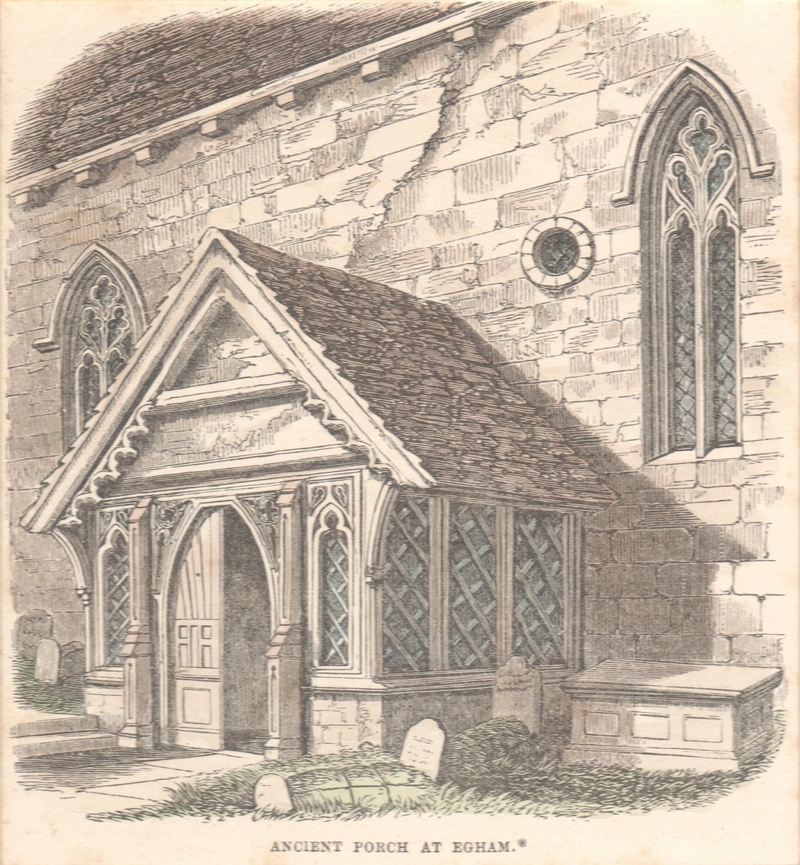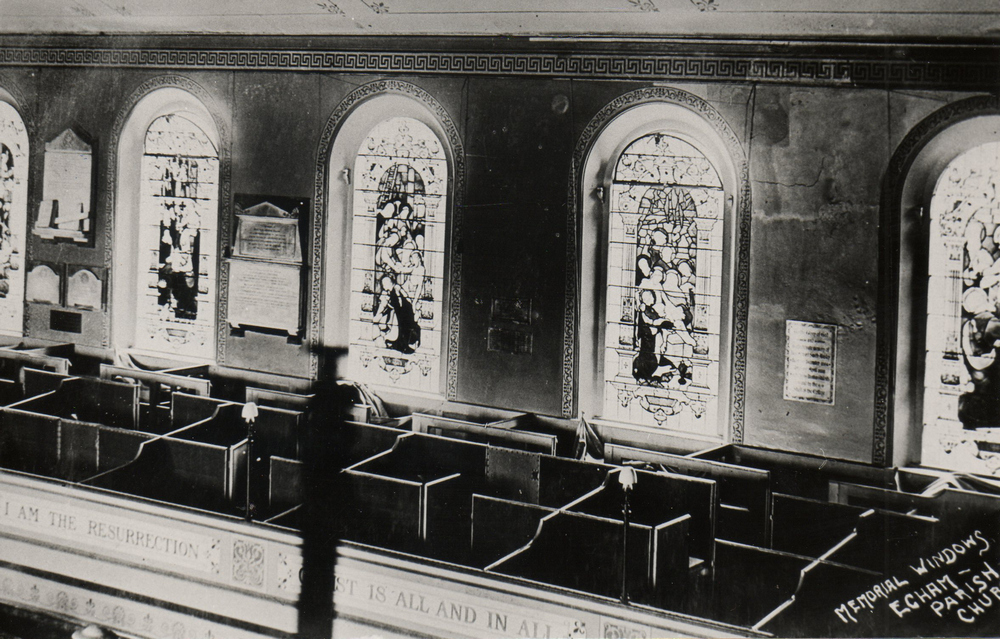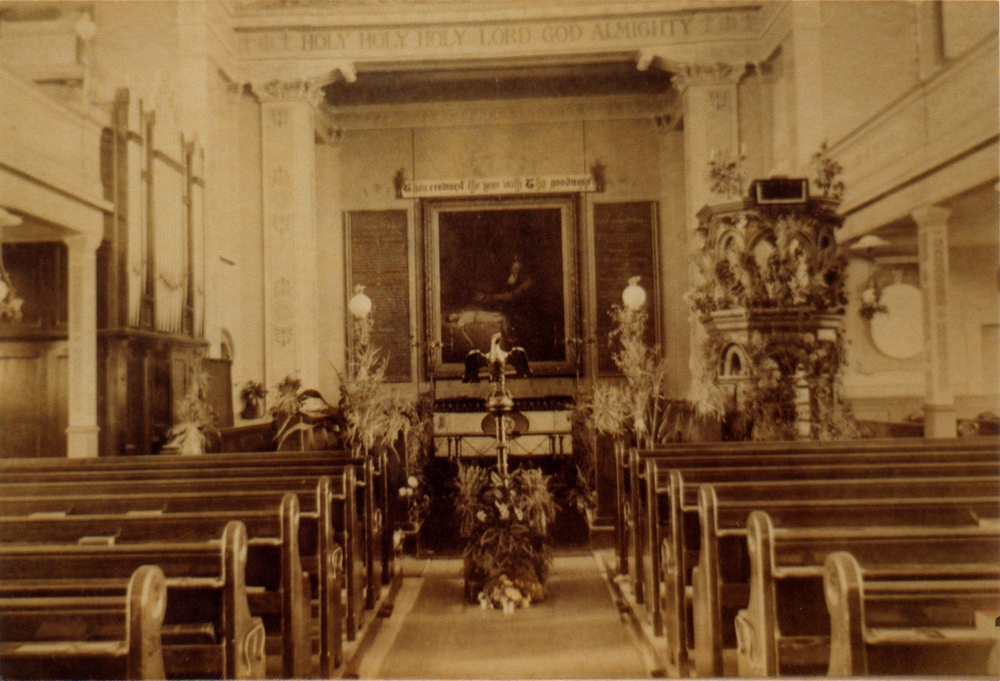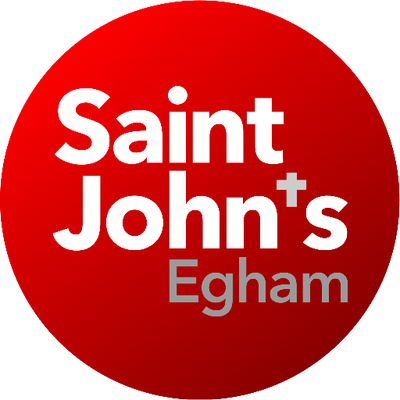St John’s Church building at 200 – Part 1
Celebrating the bicentenary of the current building of St John’s Church, 1820-2020
An introduction to St John’s Church
The year 2020 marks 200 years since the first service was held in the current Egham Parish Church of St John the Baptist. However, there has been a church on the site since the Saxon period, with some suggestions this could be as early as 637AD. Originally, any church would have been a crude wooded structure that served the small Egham village, on land given into the ownership of Chertsey Abbey between 666-672AD.[1]
During the planned medieval development of Egham, this early church was eventually replaced by a Norman building of stone in the mid-12th century. Over the following years, a south aisle and several galleries were added.[2] This building had become rather decayed by the early 19th century and was no longer large enough to accommodate the local residents, who had outgrown its 400 seats.[3]
Rebuild
At a parish meeting in April 1814,consideration was giving to the “ruinous and inconvenient state of the parish church”. A committee was appointed and plans were soon drawn up.[4] The designer of the current church building was Henry Rhodes who was heavily influenced by the architectural style of Sir John Soanes.[5] The building work was undertaken by Robert Pinney at an original estimate of £6,155. The final bill however, with all the additions and refinements was nearer £8,000.[6] The work began in 1817 after significant fundraising which included £1,600 donated by George III.[7] He died less than two months before it the first service which was held on Sunday 16th March 1820.
The new church did not find favour with everyone. The Reverend Dr John Samuel Bewley Monsell, famous hymn writer of “Fight the Good Fight”, who was vicar in Egham from 1853 to 1870 wrote, “My parish church is so bad in form and feature that its influence must be, no matter how people struggle against it, to unsolemnise”.[8]
A Pevsner Guide to Churches (by Ian Nairn) also disliked the style, stating “It is a very ugly building, showing the strange effect of following Soane’s ideas on proportion and detail without Soane’s spatial imagination”.[9]

Image Credit: St John’s Church
While the current Parish Church has completely replaced the previous Norman building, many features were saved and repositioned in the new venue.
The Lych Gate was once in front of the north door of the church. On demolition, the Lych gate was removed and put in a garden in Bakeham Lane. In 1938 it was returned to the church and can now be seen at the entrance to the churchyard. This Lych Gate was where John Wesley (founder of Methodism) preached in 1744 and is now grade two listed.
The church was designed in the classical style, with a large unsupported ceiling and clear view towards the sanctuary from the back of the church.
Inside Egham’s Parish Church
In 1896, the original box seating in the main body of the church fitted out for 1,100 people, being replaced with pews. There was a large refurbishment that same year, with services being temporarily held in the Literary Institute in 1896.[10]
A more recent refurbishment in 1999 saw the congregation sit in chairs instead of traditional pews, with a few of the original Victorian and Georgian pews moved to the galleries. A raised dais is used to give the entire congregation a good view of the vicar during the service. The furniture on the dais was designed by a member of the local parish, Robert Bannister. A full immersion Baptismal pool was also installed.
The decorative stained-glass windows we see in the church today were not part of the initial rebuild of 1817-1820.The 6 windows in the gallery were made by Arthur Louis Moore and donated by the Royal Indian Engineering College when it closed in 1906. They are dedicated to the memory of former students who passed away. The 2 windows in the auditorium are in memory of J E Hutchings (church warden 1885 to 1910) and his daughter.
St John’s Church played a part in the history of the Magna Carta, as the Archbishop of Canterbury, Cardinal Stephen Langton, prayed for King John the night before the charter was sealed in 1215.

Image Credit: Egham Museum P1128
The links between the church and Magna Carta were also significant for Reverend Tranter who wrote on the subject. Leading up to the galleries on both sides of the church are replicas of the coats of arms of the barons chosen as Sureties to defend Magna Carta which was finally sealed on Runnymede. The shields included Robert Vere, William de Hardell, William Mallet, and Gilbert de Clare and were produced and given to the church from the descendants of the Barons in c.1936.
The Church also holds a copy of the Magna Carta with the seals of the Barons and King John.[11]

Image Credit: Egham Museum P885
The Sanctuary
‘Thou crownest the year with thy goodness’
Before subsequent refurbishments, the sanctuary was decorated with the phrases “Holy Holy Holy Lord God almighty” and “thou crownest the year with thy goodness.” The first phrase is derived from the hymn of the same name written by Reginald Heber in the 19th century. The second phrase is from Psalm 65:11, concerned with harvest thanksgiving, normally celebrated in September. The harvest festival is of significance to Egham, with the former Vicar of St. John’s Dr. John Monsell writing a harvest hymn himself in the 19th century.
Over the past 200 years, there have been 2 pulpit changes, one in 1948 and the other in 1999. In memory of Reverend Albert Cecil Tranter, who had served the parish for 30 years, a 200-year-old pulpit dating from 1755, according to a panel inside it, was installed. This pulpit was removed in 1999 when the church was refurbished, and the dedication to Reverend Tranter was moved to the altar behind inside the sanctuary.
The new pulpit was proposed in 1948, a year after Rev. Tranter’s death, in the same year the church went under an ambitious renovation project. By April, the £200 for a 1775 pulpit was raised, and the previous pulpit was given to a church in Old Kent Road, London that was affected by the blitz. The pulpit was first used on May 30th, placed where the church organ once stood. An official service to celebrate the memorial for Rev. Tranter took place June 24th 1948.[12]
On the left-hand side of the church, there is a portrait of the prophet Elijah that once was part of a larger image by Richard Westall, art tutor to the young Princess Victoria. It originally hung between the 10 commandments and depicted Elijah raising to life the widow’s son, asking God to give him life once more. It was given to the church by the directors of the British Institute[13] in response to the appeals by Lord Bulkeley and Sir H Freemantle. In 1949, a person intending to commit arson in the church destroyed most of the large painting, leaving behind this portion of the portrait.
Inside the sanctuary are 2 marble statues on either side, both made by the Georgian sculptor John Flaxman and his pupil Bailey. On the left is a representation of ‘religion’, with ‘hope’ represented on the right with an anchor. Beside each figure is an urn to symbolize death and a medallion to show the portrait of the deceased members of the Gostling family. Above these sculptures are two more made solely by Bailey depicting a child’s memory in the charge of her guardian angel. Between the Ten Commandments is a painting of the Epiphany scene created by Hans Feibusch in 1951.

Image Credit: St John’s Church

In partnership with St John’s Church
[1] Turner’s Egham, p.77
[2] Ibid
[3] ‘Let Me Introduce You, A Little Guide’ by John Northridge, 1949, p.8
[4] St John’s Church website, https://www.stjohnsegham.com/about-us/our-history/
[5] ‘Sir John Soane? Influence on Architecture from 1791: A Continuing Legacy’ by Oliver Bradbury, p.83
[6] St John’s Church website, https://www.stjohnsegham.com/about-us/our-history/
[7] ‘Let Me Introduce You, A Little Guide’ by John Northridge, 1949, p.7
[8] St John’s Church website, https://www.stjohnsegham.com/about-us/our-history/
[9] ‘Sir John Soane? Influence on Architecture from 1791: A Continuing Legacy’ by Oliver Bradbury, p.83
[10] From Surrey Herald 22nd August 1896
[11] From DOC4948 a pamphlet by Rev. Tranter, no date but definitely post 1936 and likely towards 1947 since he mentions the falling ceiling that was fixed in 1948
[12] From various issues of the Staines and Egham news throughout 1948
[13] Ibid
[14] From Surrey herald 12th September 1896
[15] ‘Let Me Introduce You, A Little Guide’ by John Northridge, 1949, p.7


